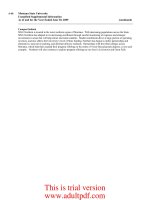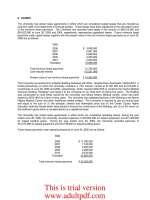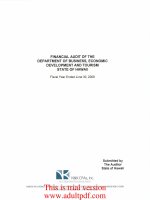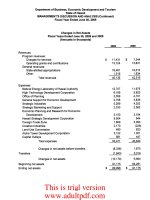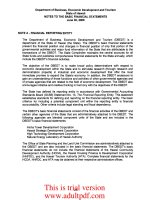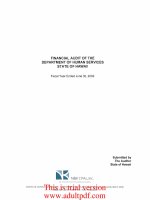Audited Financial Financial Statements The Pennsylvania State University Fiscal Year Ended June 30, 2005_part3 pptx
Bạn đang xem bản rút gọn của tài liệu. Xem và tải ngay bản đầy đủ của tài liệu tại đây (33.24 KB, 6 trang )
19
8. LEASES
The University has certain lease agreements in effect which are considered capital leases that are included as
long-term debt in the statements of financial position. These leases have been capitalized at the net present value
of the minimum lease payments. The University has recorded fixed assets in the amount of $28,312,000 and
$24,022,000 at June 30, 2005 and 2004, respectively, representing capitalized leases. Future minimum lease
payments under capital leases together with the present value of the net minimum lease payments as of June 30,
2005 are as follows:
Year
2006 $ 3,088,000
2007 2,841,000
2008 2,668,000
2009 2,305,000
2010 2,023,000
Thereafter 18,868,000
Total minimum lease payments 31,793,000
Less imputed interest (12,531,000
)
Present value of net minimum lease payments $ 19,262,000
The University has entered into a Master Building Sublease with ADG - Hospital Drive Associates ("ADG-HDA"), a
limited partnership (of which the University maintains a 75% interest, carried at $1,091,000 and $1,016,000 in
investments at June 30, 2005 and 2004, respectively), which required ADG-HDA to construct the Centre Medical
Sciences Building ("Building") and lease it to the University for an initial term of twenty-five years. The Building
was constructed on land jointly owned by the University and Mount Nittany Medical Center, which has been
leased by ADG-HDA for a term of sixty years. The University has subleased portions of the Building to the Mount
Nittany Medical Center and other healthcare related entities. The University is required to pay an annual base
rent equal to the sum of (1) the principal, interest and redemption price due on the Centre County Higher
Education Authority Bonds which were issued to finance the construction of the Building, and (2) an 8% return on
the landlord's equity which is included above as a capitalized lease.
The University has certain lease agreements in effect which are considered operating leases. During the year
ended June 30, 2005, the University recorded expenses of $18,654,000 for leased equipment and $11,000,000
for leased building space. During the year ended June 30, 2004, the University recorded expenses of
$15,075,000 for leased equipment and $10,168,000 for leased building space.
Future lease payments under operating leases as of June 30, 2005 are as follows:
Year
2006 $ 11,200,000
2007 7,145,000
2008 5,480,000
2009 3,290,000
2010 2,572,000
Thereafter 22,665,000
Total minimum lease payments $ 52,352,000
This is trial version
www.adultpdf.com
20
9. RETIREMENT BENEFITS
The University provides retirement benefits for substantially all regular employees, primarily through either
contributory defined benefit plans administered by the Commonwealth of Pennsylvania State Employees'
Retirement System and The Public School Employees' Retirement System or defined contribution plans
administered by the Teachers Insurance and Annuity Association – College Retirement Equity Fund and Fidelity
Investments. The University is billed for its share of the estimated actuarial cost of the defined benefit plans
($4,642,000 and $1,994,000 for the years ended June 30, 2005 and 2004, respectively). The University’s total
cost for retirement benefits, included in expenses, is $78,356,000 and $70,382,000 for the years ended June 30,
2005 and 2004, respectively.
10. POSTRETIREMENT BENEFITS
The University sponsors a retiree medical plan covering eligible retirees and eligible dependents. This plan
includes hospital, surgical, major medical coverage and Medicare Risk HMO’s and provides a Medicare
Supplement for individuals over age 65. In addition, the University provides retiree life insurance benefits of either
$5,000 at the time of death at no cost to the employee or additional coverage for eligible employees up to a
maximum of $10,000, provided the individual makes the required contributions.
Retirees are eligible for medical coverage and life insurance at age 60 if they have at least 15 years of regular full-
time employment and participation in a University-sponsored medical plan (for those hired prior to August 1, 1984,
ten years is required), or at an earlier age if they have at least 25 years of service and ten years of continuous
participation in a University-sponsored medical plan immediately preceding the retirement date.
The retiree medical and life plans are generally self-funded programs, except for Medicare Risk HMO’s, and all
medical claims, death benefits and other expenses are paid from the unrestricted net assets of the University.
The retirees contribute varying amounts for coverage under the medical plan. As of January 1, 2005, the monthly
rates ranged from $7 to $328 depending on age and dependent coverage options selected. Life insurance
contributions are $13 semi-annually.
The following sets forth the plan's benefit obligation, plan assets and funded status reconciled with the amounts
recognized in the University's consolidated statements of financial position at June 30:
Change in benefit obligation:
2005
2004
Benefit obligation at beginning of year $ 748,170,000 $ 752,382,000
Service cost 32,011,000 32,781,000
Interest cost 45,423,000 42,903,000
Actuarial loss/(gain) 5,559,000 (50,654,000)
Benefits paid (26,129,000
) (29,242,000)
Benefit obligation at end of year $ 805,034,000 $ 748,170,000
Change in plan assets:
2005
2004
Fair value of plan assets at beginning of year $ - $ -
Employer contributions 26,129,000 29,242,000
Benefits paid (26,129,000
) (29,242,000)
Fair value of plan assets at end of year $ -
$ -
Funded status $ (805,034,000) $ (748,170,000)
Unrecognized prior service cost 266,000 315,000
Unrecognized net actuarial loss 188,329,000
189,759,000
Accrued postretirement benefit expense $ (616,439,000
) $ (558,096,000)
This is trial version
www.adultpdf.com
21
Net periodic postretirement cost includes the following components for the years ended June 30:
2005
2004
Service cost $ 32,012,000 $ 32,781,000
Interest cost 45,422,000 42,903,000
Amortization of prior service cost 48,000 48,000
Amortization of unrecognized net loss 6,989,000
9,687,000
Net periodic postretirement cost $ 84,471,000 $ 85,419,000
The assumed healthcare cost trend rate used in measuring the accumulated postretirement benefit obligation was
9.00% and 9.50% for the 2004-2005 and 2003-2004 plan years, respectively, reduced by 0.50% per year to a
fixed level of 6.00%. The weighted average postretirement benefit obligation discount rate was 5.25% and 6.25%
for the years ended June 30, 2005 and 2004, respectively.
If the healthcare cost trend rate assumptions were increased by 1% in each year, the accumulated postretirement
benefit obligation would be increased by $153,202,000 and $138,623,000 as of June 30, 2005 and 2004,
respectively. The effect of this change on the sum of the service cost and interest cost components of the net
periodic postretirement benefit cost would be an increase of $16,952,000 and $17,480,000 as of June 30, 2005
and 2004, respectively. If the healthcare cost trend rate assumptions were decreased by 1% in each year, the
accumulated postretirement benefit obligation would be decreased by $120,541,000 and $109,508,000 as of June
30, 2005 and 2004, respectively. The effect of this change on the sum of the service cost and interest cost
components of the net periodic postretirement benefit cost would be a decrease of $13,081,000 and $13,342,000
as of June 30, 2005 and 2004, respectively.
Gains and losses in excess of 10% of the accumulated postretirement benefit obligation are amortized over the
average future service to assumed retirement of active participants.
In 2004, the Financial Accounting Standards Board issued FASB Staff Position No. FAS 106-2, “Accounting and
Disclosure Requirements Related to the Medicare Prescription Drug, Improvement and Modernization Act of
2003”. This Act introduces a prescription drug benefit under Medicare. The University incurred a $130,420,000
reduction in the accumulated benefit obligation related to this subsidy at June 30, 2005. The subsidy had no effect
on the measurement of the net periodic postretirement benefit cost for 2005, although there will be an effect in
2006 and beyond.
11. THE MILTON S. HERSHEY MEDICAL CENTER
The University’s wholly-owned subsidiary, TMSHMC, owns the assets of the clinical enterprise of the Hershey
Medical Center complex. The University owns the Hershey Medical Center complex, including all buildings and
land occupied by the University Hospital and operates the College of Medicine. The clinical facilities of the
Hershey Medical Center complex are leased to TMSHMC and TMSHMC makes certain payments to support
the College of Medicine.
Hospital operations expense includes academic support payments in support of medical education of
$35,944,000 and $36,391,000 for the years ended June 30, 2005 and 2004, respectively.
12. CONTINGENCIES AND COMMITMENTS
Contractual Obligations
The University has contractual obligations for the construction of new buildings and for additions to existing
buildings in the amount of $486,951,000 of which $365,962,000 has been paid or accrued as of June 30, 2005.
The contract costs are being financed from available resources and from borrowings.
This is trial version
www.adultpdf.com
22
Under the terms of certain limited partnership agreements, the University is obligated to periodically advance
additional funding for private equity and real estate investments. The University has unfunded commitments of
approximately $134,496,000 as of June 30, 2005 for which capital calls have not been exercised. Such
commitments generally have fixed expiration dates or other termination clauses. The University maintains
sufficient liquidity in its investment portfolio in the event that such calls are exercised.
Letters of Credit
The University has outstanding letters of credit in the amount of $11,332,000 and $8,550,000 as of June 30, 2005
and 2004, respectively. These letters of credit are used primarily to comply with minimum state and federal
regulatory laws that govern various University activities. The fair value of these letters of credit approximates
contract values based on the nature of the fee arrangements with the issuing banks.
Self-Insurance
The University has a coordinated program of commercial and self-insurance for medical malpractice claims at
TMSHMC through the use of a domestic captive insurance company in combination with a self-insured retention
layer and is supplementing this program through participation in the Pennsylvania Medical Care Availability and
Reduction of Error Fund (“Mcare Fund”), formerly the Pennsylvania Medical Professional Liability Catastrophe
Loss Fund (“CAT Fund”), in accordance with Pennsylvania law. An estimate of the present value, discounted at
4%, of the medical malpractice claims liability in the amount of $70,896,000 and $56,182,000 is recorded as of
June 30, 2005 and 2004, respectively.
On July 1, 2003, TMSHMC became self-insured for all medical malpractice claims asserted on or after July 1,
2003, for all amounts that are below the coverage of the TMSHMC’s excess insurance policies and not included in
the insurance coverage of the Mcare Fund. Under the self-insurance program, TMSHMC is required to maintain a
malpractice trust fund in an amount at least equal to the expected loss of known claims. The balance of this trust
fund was $14,463,000 and $10,906,000 at June 30, 2005 and 2004, respectively.
With approval from the Pennsylvania Department of Labor and Industry (“PA-DLI”), the University elected to self-
insure potential obligations applicable to workers' compensation. Certain claims under the program are
contractually administered by a private agency. The University purchased insurance coverage for excess
obligations over $600,000 per incident. An estimate of the self-insured workers' compensation claims liability in
the amount of $6,734,000 and $5,555,000 is recorded as of June 30, 2005 and 2004, respectively. The University
has established a trust fund, in the amount of $8,937,000 and $7,388,000 at June 30, 2005 and June 30, 2004,
respectively, as required by PA-DLI, to provide for the payment of claims under this self-insurance program.
TMSHMC is self-insured for workers’ compensation claims and has purchased an excess policy through a
commercial insurer which covers individual claims in excess of $500,000 per incident for workers’ compensation
claims.
The University and TMSHMC are self-insured for certain health care benefits provided to employees. The
University and TMSHMC have purchased excess policies which cover employee health benefit claims in excess of
$500,000 and $300,000 per year, respectively. The University and TMSHMC provide for reported claims and
claims incurred but not reported.
Litigation and Contingencies
Various legal proceedings have arisen in the course of conducting University business. The outcome of such
litigation is not expected to have a material effect on the financial position of the University.
Based on its operation of the University Hospital (see Note 11), the University, like the healthcare industry, is
subject to numerous laws and regulations of federal, state and local governments. Compliance with these laws
and regulations can be subject to government review and interpretation, as well as regulatory actions. Recently,
government reviews of healthcare providers for compliance with regulations have increased. Although the
University believes it has done its best to comply with these numerous regulations, such government reviews
could result in significant repayments of previously billed and collected revenues from patient services.
This is trial version
www.adultpdf.com
APPOINTED BY THE GOVERNOR MEMBERS EX OFFICIO ELECTED BY ALUMNI
CYNTHIA A. BALDWIN EDWARD G. RENDELL MARIANNE E. ALEXANDER
Judge, Allegheny County Governor of the Commonwealth* President Emerita
Court of Common Pleas Public Leadership Education Network
DENNIS C. WOLFF
EUGENE B. CHAIKEN Secretary, Department of Agriculture H. JESSE ARNELLE
Chairman/CEO, Almo Corp. Of Counsel
GERALD L. ZAHORCHAK Womble, Carlyle, Sandridge and Rice
ALVIN H. CLEMENS Acting Secretary, Department of Education
Chairman and President STEVE A. GARBAN
The Provident MICHAEL DIBERARDINIS Senior Vice President for Finance and
Secretary, Department of Conservation Operations/Treasurer Emeritus
JOE CONTI and Natural Resources The Pennsylvania State University
State Senator
GRAHAM B. SPANIER GEORGE T. HENNING, JR.
GALEN FOULKE President of the University Business Consultant and Retired CFO
Student LTV Corporation
ROBERT C. DANIELS*
PATRICIA K. POPRIK Attorney/Partner DAVID R. JONES
President, First American Municipals Inc. Braverman Daniels Kaskey, LTD Retired Assistant Managing Editor
*Governor's Non-Voting Representative The New York Times
ELECTED BY DELEGATES FROM ELECTED BY BOARD REPRESENTING DAVID M. JOYNER
AGRICULTURAL SOCIETIES BUSINESS AND INDUSTRY Orthopedic Physician
CHARLES C. BROSIUS JAMES S. BROADHURST JOEL N. MYERS
Retired President Chairman and CEO Founder, President and Chairman of the Board
Marlboro Mushrooms Eat'n Park Hospitality Group, Inc. AccuWeather, Inc.
KEITH W. ECKEL EDWARD R. HINTZ, JR. ANNE RILEY
Partner, Fred W. Eckel Sons Farms, Inc. President English Teacher
Hintz, Holman & Robillard, Inc.
SAMUEL E. HAYES, JR. PAUL V. SUHEY
EDWARD P. JUNKER III Orthopedic Surgeon
BETSY E. HUBER Retired Vice Chairman University Orthopedics and Sports Medicine
Master, National Grange PNC Bank Corp.
WALTER N. PEECHATKA ROBERT D. METZGAR
Executive Vice President CEO, North Penn Pipe & Supply, Inc.
PennAg Industries Association
L. J. ROWELL, JR.
CARL T. SHAFFER Retired Chairman and CEO
Vice President Provident Mutual Life Insurance Company
Pennsylvania Farm Bureau
LINDA B. STRUMPF
Vice President and Chief Investment Officer
The Ford Foundation
EMERITI TRUSTEES
MARY G. BEAHM J. LLOYD HUCK NANCY VAN TRIES KIDD
Corporate Vice President of Human Resources Retired President, Merck & Co., Inc. Psychologist and Mediator
C-COR.net Corp. Psychological and Mediation Resources
ROGER A. MADIGAN
HOWARD O. BEAVER, JR. State Senator HELEN D. WISE
Retired Chairman of the Board and CEO Retired from Government and Education
Carpenter Technology Corporation DAVID A. MORROW
Owner Manager, Arch Spring Farm BOYD E. WOLFF
WALTER J. CONTI Retired Owner and Operator
Retired Owner BARRY K. ROBINSON Wolfden Farms
Cross Keys Inn/Pipersville Inn Senior Counsel for Corporate Affairs
Recording Industry Association of America QUENTIN E. WOOD
DONALD M. COOK, JR. Retired Chairman of the Board and CEO
Retired President, SEMCOR, Inc. STANLEY G. SCHAFFER Quaker State Corporation
Retired President, Duquesne Light Company
MARIAN U. COPPERSMITH FREDMAN EDWARD P. ZEMPRELLI
Chairman of the Board WILLIAM A. SCHREYER Attorney
The Barash Group Chairman Emeritus, Merrill Lynch & Co., Inc.
ROBERT M. FREY CECILE M. SPRINGER
Attorney-at-Law, Frey & Tiley, P. C. President, Springer Associates
as of September 30, 2005
BOARD OF TRUSTEES
T H E P E N N S Y L V A N I A S T A T E U N I V E R S I T Y
This is trial version
www.adultpdf.com
This publication is available in alternative media on request.
The Pennsylvania State University is committed to the policy that all persons shall have equal access to programs, facilities, admission, and employment
without regard to personal characteristics not related to ability, performance, or qualifications as determined by University policy or by state or federal
authorities. The Pennsylvania State University does not discriminate against any person because of age, ancestry, color, disability or handicap, national
origin, race, religious creed, sex, sexual orientation, or veteran status. Direct all inquiries regarding the nondiscrimination policy to the Affirmative Action
Director, The Pennsylvania State University, 328 Boucke Building, University Park PA 16802-5901; tel. (814) 863-0471.
This is trial version
www.adultpdf.com
